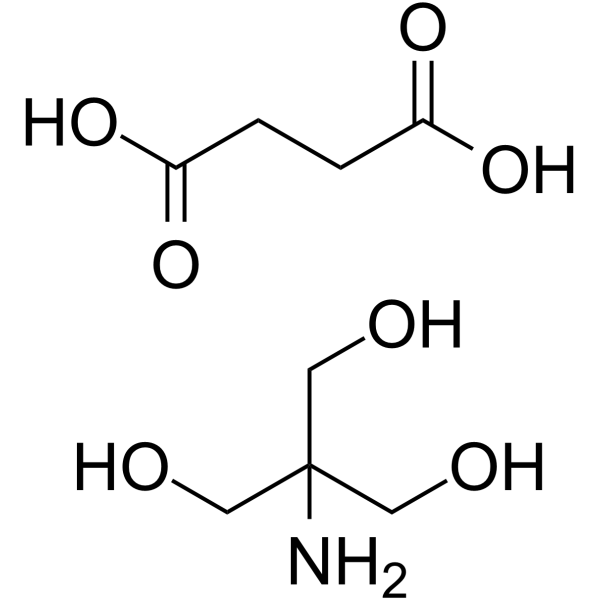84540-64-7
| 中文名 | 三-琥珀酸 |
|---|---|
| 英文名 | tris succinate |
| 英文别名 |
TRIS(HYDROXYMETHYL)AMINOMETHANE SUCCINATE
TRIS-SUCCINATE succinic acid,compound with 2-amino-2-(hydroxymethyl)propane-1,3-diol (1:1) TRIZMA SUCCINATE DI[TRIS(HYDROXYMETHYL)AMINOMETHANE] SUCCINATE 2-AMINO-2-(HYDROXYMETHYL)-1,3-PROPANEDIOL SUCCINATE |
| 描述 | 丁二酸氨丁三醇是一种有效的口服抗焦虑剂。丁二酸氨丁三醇是三羧酸循环的中间产物。丁二酸氨丁三醇可作为食品、化学和制药工业中许多重要工业化学品的前体[1][2][3]。 |
|---|---|
| 相关类别 | |
| 靶点 |
Microbial Metabolite Human Endogenous Metabolite |
| 体外研究 | 丁二酸氨丁三醇来自农业碳水化合物的发酵[2]。 |
| 体内研究 | 丁二酸氨丁三醇(3,6 mg/kg;p.o.)增加雄性小鼠伸开双臂的百分比和伸开双臂花费的时间[3]。丁二酸氨丁三醇(3、6、12 mg/kg;i.p.)在给药后5分钟和40分钟内显著增加食物摄入。测量直肠温度后,丁二酸的剂量为1.5 mg/kg,可抑制应激诱导的高温[3]。 |
| 参考文献 |
[3]. Si Wei Chen, Anxiolytic-like effect of succinic acid in mice. Life Sci. 2003 Nov 7;73(25):3257-64. |
| 沸点 | 633.5ºC at 760 mmHg |
|---|---|
| 熔点 | 138-141ºC |
| 分子式 | C12H28N2O10 |
| 分子量 | 360.35800 |
| 闪点 | 336.9ºC |
| 精确质量 | 360.17400 |
| PSA | 248.02000 |
Synonym:Tris(hydroxymethyl)aminomethane succinate Section 2 - COMPOSITION, INFORMATION ON INGREDIENTS
Risk Phrases: None Listed. Section 3 - HAZARDS IDENTIFICATION EMERGENCY OVERVIEW
Not available. Potential Health Effects Eye: May cause eye irritation. Skin: May cause skin irritation. Ingestion: The toxicological properties of this substance have not been fully investigated. Inhalation: Dust is irritating to the respiratory tract. Chronic: No information found. Section 4 - FIRST AID MEASURES Eyes: Flush eyes with plenty of water for at least 15 minutes, occasionally lifting the upper and lower eyelids. Get medical aid. Skin: Flush skin with plenty of water for at least 15 minutes while removing contaminated clothing and shoes. Get medical aid if irritation develops or persists. Ingestion: Get medical aid. Wash mouth out with water. Inhalation: Remove from exposure and move to fresh air immediately. Get medical aid if cough or other symptoms appear. Notes to Physician: Section 5 - FIRE FIGHTING MEASURES General Information: As in any fire, wear a self-contained breathing apparatus in pressure-demand, MSHA/NIOSH (approved or equivalent), and full protective gear. Extinguishing Media: Use foam, dry chemical, or carbon dioxide. Section 6 - ACCIDENTAL RELEASE MEASURES General Information: Use proper personal protective equipment as indicated in Section 8. Spills/Leaks: Vacuum or sweep up material and place into a suitable disposal container. Avoid generating dusty conditions. Provide ventilation. Section 7 - HANDLING and STORAGE Handling: Wash thoroughly after handling. Remove contaminated clothing and wash before reuse. Use with adequate ventilation. Avoid contact with eyes, skin, and clothing. Avoid breathing dust. Storage: Store in a cool, dry place. Store in a tightly closed container. Section 8 - EXPOSURE CONTROLS, PERSONAL PROTECTION Engineering Controls: Facilities storing or utilizing this material should be equipped with an eyewash facility and a safety shower. Exposure Limits CAS# 84540-64-7: Personal Protective Equipment Eyes: Wear appropriate protective eyeglasses or chemical safety goggles as described by OSHA's eye and face protection regulations in 29 CFR 1910.133 or European Standard EN166. Skin: Wear appropriate protective gloves to prevent skin exposure. Clothing: Wear appropriate protective clothing to minimize contact with skin. Respirators: A NIOSH/MSHA approved air purifying dust or mist respirator or European Standard EN 149. Section 9 - PHYSICAL AND CHEMICAL PROPERTIES Physical State: Powder Color: white Odor: Not available. pH: Not available. Vapor Pressure: Not available. Viscosity: Not available. Boiling Point: Not available. Freezing/Melting Point: 138 - 141 deg C Autoignition Temperature: Not available. Flash Point: Not applicable. Explosion Limits, lower: Not available. Explosion Limits, upper: Not available. Decomposition Temperature: Solubility in water: soluble in water 1 g/10ml Specific Gravity/Density: Molecular Formula: C8H22N2O6.C4H6O4 Molecular Weight: 360.35 Section 10 - STABILITY AND REACTIVITY Chemical Stability: Stable under normal temperatures and pressures. Conditions to Avoid: Dust generation. Incompatibilities with Other Materials: Strong oxidizing agents. Hazardous Decomposition Products: Carbon monoxide, oxides of nitrogen, carbon dioxide. Hazardous Polymerization: Has not been reported. Section 11 - TOXICOLOGICAL INFORMATION RTECS#: CAS# 84540-64-7 unlisted. LD50/LC50: Not available. Carcinogenicity: Tris-succinate - Not listed by ACGIH, IARC, or NTP. Section 12 - ECOLOGICAL INFORMATION Section 13 - DISPOSAL CONSIDERATIONS Dispose of in a manner consistent with federal, state, and local regulations. Section 14 - TRANSPORT INFORMATION IATA Shipping Name: Not regulated. Hazard Class: UN Number: Packing Group: IMO Shipping Name: Not regulated. Hazard Class: UN Number: Packing Group: RID/ADR Shipping Name: Not regulated. Hazard Class: UN Number: Packing group: Section 15 - REGULATORY INFORMATION European/International Regulations European Labeling in Accordance with EC Directives Hazard Symbols: Not available. Risk Phrases: Safety Phrases: S 24/25 Avoid contact with skin and eyes. WGK (Water Danger/Protection) CAS# 84540-64-7: No information available. Canada None of the chemicals in this product are listed on the DSL/NDSL list. CAS# 84540-64-7 is not listed on Canada's Ingredient Disclosure List. US FEDERAL TSCA CAS# 84540-64-7 is not listed on the TSCA inventory. It is for research and development use only. SECTION 16 - ADDITIONAL INFORMATION N/A |
| 安全声明 (欧洲) | 24/25 |
|---|

